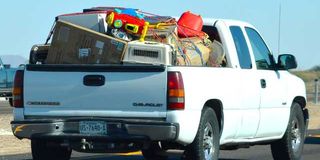Loose luggage can turn into missiles

No loose objects should be carried in the passenger compartment of a car.
Station wagons and 4WD estates often carry a lot of luggage in the back. What are the chances of that load bombarding the occupants in the event of an accident? How serious could the consequences be and what can be done to reduce or prevent the risk?
No loose (unrestrained) objects should be carried in the passenger compartment of a car. Especially if the items are hard, sharp or heavy.
In saloon cars they should be put in the boot, where the chances of them entering a passenger compartment, under any likely circumstance, are vanishingly small. The rear bulkhead and rear seat backs present a solid barrier that completely separates the load/people spaces.
In station wagons and estates, people and luggage share the same space. So in the event of an accident (or even a big bounce or a sudden swerve or violent braking) there is a very real possibility of items in the back sliding, falling and even flying into the passengers further forward. With surprising speed and force. Even a furled umbrella can have the potency of a spear.
Ideally, there should be a strong and secure rope net in the gap between the roof and the back seats.
In some countries that is a legal requirement. An effective alternative is to cover the load in a robust tarpaulin and tie it down with rope or straps. Most modern estates have steel loops in the load-bed floor to facilitate that.
This is a sensible precaution at any time, but especially if the load is stacked quite high and certainly if the load pile is higher than the backs of the rear seats.
Whichever of these methods or other solution you opt for, your aim should be to ensure that no part of the load can move beyond the backs of the rear seats, even in the event of a severe head-on collision or the car rolling upside down. Do not under-estimate the huge forces that can be involved, or the speed with which objects can “fly” from the back, through the passenger area and even into the windscreen.
If you are driving along at 80 kph and the vehicle comes to a sudden halt, any unrestrained object – large or small, heavy or light, soft or hard, and including human bodies - in the vehicle will keep going at 80 kph (or thereabouts) until it hits something. For the passenger, that “something” is a seatbelt or an air bag designed to stop you without smashing you. The seatbelt for luggage is a net or a tied-down tarp…or the back of your head.





